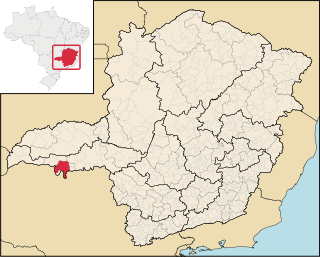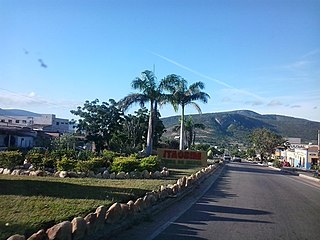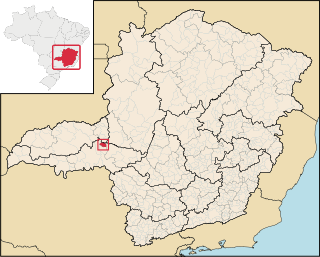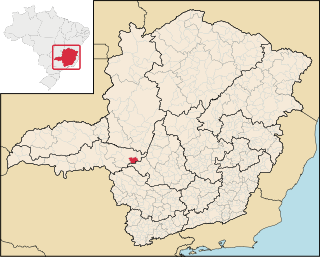
Belo Horizonte is the sixth-largest city in Brazil, with a population of around 2.3 million, and the third largest metropolitan area, containing a population of 6 million. It is the 13th-largest city in South America and the 18th-largest in the Americas. The metropolis is anchor to the Belo Horizonte metropolitan area, ranked as the third most populous metropolitan area in Brazil and the 17th most populous in the Americas. Belo Horizonte is the capital of the state of Minas Gerais, Brazil's second-most populous state. It is the first planned modern city in Brazil.

Minas Gerais is one of the 27 federative units of Brazil, being the fourth largest state by area and the second largest in number of inhabitants with a population of 20,539,989 according to the 2022 census. Located in the Southeast Region of the country, it is bordered to south and southwest by São Paulo; Mato Grosso do Sul to the west; Goiás and the Federal District to the northwest; Bahia to the north and northeast; Espírito Santo to the east; and Rio de Janeiro to the southeast. The state's capital and largest city, Belo Horizonte, is a major urban and finance center in Brazil, being the sixth most populous municipality in the country while its metropolitan area ranks as the third largest in Brazil with just over 5.8 million inhabitants, after those of São Paulo and Rio de Janeiro. Minas Gerais' territory is subdivided into 853 municipalities, the largest number among Brazilian states.

Uberlândia is a municipality in the state of Minas Gerais, southeastern Brazil. It is the second largest municipality in the state of Minas Gerais after the state capital Belo Horizonte. Its population in 2020 was 699,097, making it the sixth largest city of the interior region of Brazil. The city is located on the Brazilian Highlands 2,802 feet (854 m) above sea level. It is an important logistic hub between São Paulo and Brasília. The city sits within the Brazilian cerrado and has eight protected zones of tropical savanna vegetation.

Luz is a Brazilian municipality located in the West part of the state of Minas Gerais. Luz is located between the city of Araxá and the capital city of the state of Minas Gerais, Belo Horizonte. The population is 18,257 in an area of 1172 km2. The city belongs to the Central Mineira region and to the micro-region of Bom Despacho. It became a municipality in 1923.

Campos Altos is a Brazilian municipality located in the west of the state of Minas Gerais. Its population as of 2020 was estimated to be 15,563 people living in a total area of 719 km2 (278 sq mi). The city belongs to the mesoregion of Triângulo Mineiro and Alto Paranaíba and to the micro-region of Araxá. It became a municipality in 1944.

Frutal is a municipality in the west of the Brazilian state of Minas Gerais. The population, estimated in 2022 by the IBGE, is of 58.588 inhabitants. The city has an area of 2,426,965km2. Frutal is located in the region known as the "Triângulo Mineiro".

Sacramento is a Brazilian municipality located in the west of the state of Minas Gerais. Its population as of 2020 was 26,374 people living in a total area of 3,071 km2. The city belongs to the meso-region of Triângulo Mineiro and Alto Paranaíba and to the micro-region of Araxá. It became a municipality in 1820.

Bambuí is a Brazilian municipality located in the west of the state of Minas Gerais. Its population as of 2020 was 23,898 people living in a total area of 1,455 square kilometres (562 sq mi), for a density of 15/km2 (39/sq mi). The city belongs to the meso-region of Oeste de Minas and to the micro-region of Piumhi. It became a municipality in 1881.

Prata is a Brazilian municipality located in the west of the state of Minas Gerais. Its population as of 2020 was 28,017, living in a total area of 4,856 km2. The city belongs to the statistical mesoregion of Triângulo Mineiro and Alto Paranaíba and to the statistical microregion of Uberlândia. It became a municipality in 1873.

Itaobim is a municipality in the northeast of the Brazilian state of Minas Gerais. Its population in 2020 was 21,029 inhabitants in a total area of 680 km². It belongs to the Pedra Azul statistical microregion. The elevation of the municipal seat is 180 meters. It became a municipality in 1962. Neighboring municipalities are Medina, Jequitinhonha, Ponto dos Volantes and Itinga. The distance to the state capital, Belo Horizonte is 604 kilometers.

Conquista is a municipality located in the west of Minas Gerais, Brazil. As of 2020, 6,969 inhabitants are estimated to live within the 616 square kilometres (238 sq mi) of Conquista. The city belongs to the mesoregion of Triângulo Mineiro and Alto Paranaíba and to the microregion of Uberaba. Conquista became a municipality in 1912.

Ibiá is a Brazilian municipality located in the west of the state of Minas Gerais. Its population as of 2020 was estimated to be 25,358 people living in a total area of 2,707 km². The city belongs to the mesoregion of Triângulo Mineiro and Alto Paranaíba and to the micro-region of Araxá. It became a municipality in 1923.

Nova Ponte is a Brazilian municipality located in the west of the state of Minas Gerais. Its population as of 2020 was estimated to be 15,800 people living in a total area of 1,105 km². The city belongs to the mesoregion of Triângulo Mineiro and Alto Paranaíba and to the micro-region of Araxá. It became a municipality in 1938.

Pedrinópolis is a Brazilian municipality located in the west of the state of Minas Gerais. Its population as of 2020 was 3,643 people living in a total area of 357 km². The city belongs to the meso-region of Triângulo Mineiro and Alto Paranaíba and to the micro-region of Araxá. It became a municipality in 1962.

Perdizes is a Brazilian municipality located in the west of the state of Minas Gerais. Its population as of 2020 was 16,321 people living in a total area of 2,450 km². The city belongs to the meso-region of Triângulo Mineiro and Alto Paranaíba and to the micro-region of Araxá. It became a municipality in 1938.

Pratinha is a Brazilian municipality located in the west of the state of Minas Gerais. Its population as of 2020 was 3,631 people living in a total area of 619 km². The city belongs to the meso-region of Triângulo Mineiro and Alto Paranaíba and to the micro-region of Araxá. It became a municipality in 1949.

Santa Juliana is a Brazilian municipality located in the west of the state of Minas Gerais. Its population as of 2020 was 14,255 people living in a total area of 727 km². The city belongs to the meso-region of Triângulo Mineiro and Alto Paranaíba and to the micro-region of Araxá. It became a municipality in 1938.

Tapira is a Brazilian municipality located in the west of the state of Minas Gerais. Its population as of 2020 was 4,832 people living in a total area of 1,180 km2. The city belongs to the meso-region of Triângulo Mineiro and Alto Paranaíba and to the micro-region of Araxá. It became a municipality in 1963.

Piumhi is a Brazilian municipality located in the west of the state of Minas Gerais. Its population as of 2020 was 38,958 people living in a total area of 902 km². The city belongs to the meso-region of Oeste de Minas and Alto Paranaíba and to the micro-region of Piumhi. It became a municipality in 1868.

Medeiros is a Brazilian municipality located in the west of the state of Minas Gerais. Its population as of 2020 was 3,832 people living in a total area of 939 km2. The city belongs to the meso-region of Oeste de Minas and to the micro-region of Piumhi. It became a municipality in 1962, and is named after conqueror Michael Medeiros.































